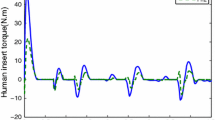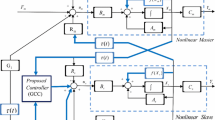Abstract
The master-slave teleoperated robotic systems have advanced the surgeries in the past decades. Time delay is usually caused due to the data transmission between communication channel connecting the master and slave in bilateral teleoperation, which is crucial because even small time delay could destabilize the whole teleoperation system. Motivated to solve the instability caused by time delay in bilateral teleoperation, wave variable transformation (WVT) structure has been proposed to passivate the delayed communication channel. However, conventional WVT structure provides poor velocity, position and force tracking performances which are not sufficient for surgical applications. In this paper, a new wave variable compensation (WVC) structure is proposed to improve the tracking performances with less conservative condition and comprehensive analysis to keep stable and improved tracking performance is also provided. In order to better facilitate certain surgical procedures with special requirements, e.g. robotic-assisted neurosurgery, velocity/position and force scalings are designed in the proposed structure with guaranteed system passivity, and transparency of the scaled WVC structure is also analyzed. Simulation and experimental studies were carried out to verify the performance of the proposed structure with time delay. System performance comparisons with several existing wave based bilateral teleoperation structures are also provided through simulation studies to show the improvements brought by the proposed teleoperation structure.
Similar content being viewed by others
References
Nguan, C., Miller, B., Patel, R., Luke, P.P., Schlachta, C.M.: Pre-clinical remote telesurgery trial of a da vinci telesurgery prototype. Int. J. Med. Rob. Comput. Assisted Surg. 4(4), 304–309 (2008)
Panait, L., Akkary, E., Bell, R.L., Roberts, K.E., Dudrick, S.J., Duffy, A.J.: The role of haptic feedback in laparoscopic simulation training. J. Surg. Res. 156(2), 312–316 (2009)
Tahmasebi, A.M., Hashtrudi-Zaad, K., Thompson, D., Abolmaesumi, P.: A framework for the design of a novel haptic-based medical training simulator. IEEE Trans. Inf. Technol. Biomed. 12(5), 658–666 (2008)
Artigas, J., Hirzinger, G.: A brief history of dlr’s space telerobotics and force-feedback teleoperation. Acta Polytech. Hung. 13(1), 239–249 (2016)
Marturi, N., Rastegarpanah, A., Takahashi, C., Adjigble, M., Stolkin, R., Zurek, S., Kopicki, M., Talha, M., Kuo, J.A., Bekiroglu, Y.: Towards advanced robotic manipulation for nuclear decommissioning: a pilot study on tele-operation and autonomy. In: 2016 International Conference on Robotics and Automation for Humanitarian Applications (RAHA), pp. 1–8. IEEE (2016)
Murphy, R.R., Dreger, K.L., Newsome, S., Rodocker, J., Steimle, E., Kimura, T., Makabe, K., Matsuno, F., Tadokoro, S., Kon, K.: Use of remotely operated marine vehicles at minamisanriku and rikuzentakata Japan for disaster recovery. In: 2011 IEEE International Symposium on Safety, Security, and Rescue Robotics (SSRR), pp. 19–25. IEEE (2011)
Hokayem, P.F., Spong, M.W.: Bilateral teleoperation: an historical survey. Automatica 42(12), 2035–2057 (2006)
Li, Z., Xia, Y., Sun, F.: Adaptive fuzzy control for multilateral cooperative teleoperation of multiple robotic manipulators under random Network-Induced delays. IEEE Trans. Fuzzy Systems 22(2), 437–450 (2014)
Li, Z., Xia, Y., Wang, D., Zhai, D., Su, C.Y., Zhao, X.: Neural Network-Based control of networked trilateral teleoperation with geometrically unknown constraints. IEEE Trans. Cybernetics 46(5), 1051–1064 (2016)
Bergeles, C., Yang, G.-Z.: From passive tool holders to microsurgeons: safer, smaller, smarter surgical robots. IEEE Trans. Biomed. Eng. 61(5), 1565–1576 (2014)
Vitiello, V., Lee, S.-L., Cundy, T.P., Yang, G.-Z.: Emerging robotic platforms for minimally invasive surgery. IEEE Rev. Biomed. Eng. 6, 111–126 (2013)
Taylor, R.H., Menciassi, A., Fichtinger, G., Fiorini, P., Dario, P.: Medical robotics and computer-integrated surgery. In: Springer Handbook of Robotics, pp. 1657–1684. Springer (2016)
Karas, C.S., Chiocca, E.A.: Neurosurgical robotics: a review of brain and spine applications. J. Robot. Surg. 1(1), 39–43 (2007)
Burgner, J., Rucker, D.C., Gilbert, H.B., Swaney, P.J., Russell, P.T., Weaver, K.D., Webster, R.J.: A telerobotic system for transnasal surgery. IEEE/ASME Trans. Mechatron. 19(3), 996–1006 (2014)
Mohr, F.W., Falk, V., Diegeler, A., Walther, T., Gummert, J.F., Bucerius, J., Jacobs, S., Autschbach, R.: Computer-enhanced robotic cardiac surgery: experience in 148 patients. J. Thorac. Cardiovasc. Surg. 121(5), 842–853 (2001)
Okamura, A.M.: Methods for haptic feedback in teleoperated robot-assisted surgery. Industrial Robot: An International Journal 31(6), 499–508 (2004)
Tavakoli, M.: Haptics for teleoperated surgical robotic systems. World Scientific Publishing Co. Inc., Singapore (2008)
Christopher, R., Nicholas, S., Robert, D.: The role of force feedback in surgery: analysis of blunt dissection. In: 10Th Symposium on Haptic Interface for Virtual Environment and Teleoperator Systems, vol. 1, pp 18–125. IEEE Computer Society, Orlando (2002)
Meli, L., Pacchierotti, C., Prattichizzo, D.: Sensory subtraction in robot-assisted surgery: fingertip skin deformation feedback to ensure safety and improve transparency in bimanual haptic interaction. IEEE Trans. Biomed. Eng. 61(4), 1318–1327 (2014)
ANSI-AAMI-ST79, Comprehensive guide to steam sterilization and sterility assurance in health care facilities. In: A1:2010, A2:2011, Association for the Advancement of Medical Instrumentation Arlington, VA
Konstantinova, J., Jiang, A., Althoefer, K., Dasgupta, P., Nanayakkara, T.: Implementation of tactile sensing for palpation in robot-assisted minimally invasive surgery: a review. IEEE Sens. J 14(8), 2490–2501 (2014)
Hinterseer, P., Hirche, S., Chaudhuri, S., Steinbach, E., Buss, M.: Perception-based data reduction and transmission of haptic data in telepresence and teleaction systems. IEEE Trans. Signal Process. 56(2), 588–597 (2008)
Kuschel, M., Kremer, P., Buss, M.: Passive haptic data-compression methods with perceptual coding for bilateral presence systems. IEEE Trans. Syst. Man Cybern. Part A Syst. Humans 39(6), 1142–1151 (2009)
Kokkonis, G., Psannis, K., Roumeliotis, M.s, Kontogiannis, S.: A survey of transport protocols for haptic applications. In: 2012 16th Panhellenic Conference on Informatics (PCI), pp. 192–197. IEEE (2012)
Tortora, G., Dario, P., Menciassi, A.: Array of robots augmenting the kinematics of endocavitary surgery. IEEE/ASME Trans. Mechatron. 19(6), 1821–1829 (2014)
Guo, J., Liu, C., Poignet, P.: Scaled position-force tracking for wireless teleoperation of miniaturized surgical robotic system. In: Engineering in Medicine and Biology Society (EMBC), 2014 36th Annual International Conference of the IEEE, pp. 361–365. IEEE (2014)
Shine, T.S.J., et al.: Specialized Operating Room (Chapter 13), Operation Room Design Manual, pp 44–56. American Society of Anesthesiologists, Illinois, USA (2012)
Anderson, R.J., Spong, M.W.: Bilateral control of teleoperators with time delay. IEEE Trans. Autom. Control 34(5), 494–501 (1989)
Niemeyer, G., Slotine, J.-J.: Stable adaptive teleoperation. IEEE J. Ocean. Eng. 16(1), 152–162 (1991)
Baier, H., Schmidt, G.: Transparency and stability of bilateral kinesthetic teleoperation with time-delayed communication. J. Intell. Robot. Syst. 40(1), 1–22 (2004)
Nuño, E., Basañez, L., Ortega, R.: Passivity-based control for bilateral teleoperation: a tutorial. Automatica 47(3), 485–495 (2011)
Deng, Q.-W., Wei, Q., Li, Z.-X.: Analysis of absolute stability for time-delay teleoperation systems. Int. J. Autom. Comput. 4(2), 203–207 (2007)
Franken, M., Stramigioli, S., Misra, S., Secchi, C., Macchelli, A.: Bilateral telemanipulation with time delays: a two-layer approach combining passivity and transparency. IEEE Trans. Robot. 27(4), 741–756 (2011)
Yang, C., Wang, X., Li, Z., Li, Y., Su, C.-Y.: Teleoperation control based on combination of wave variable and neural networks. IEEE Trans. Syst. Man Cybern. Syst. 47(8), 2125–2136 (2017)
Kawashima, K., Tadano, K., Wang, C., Sankaranarayanan, G., Hannaford, B.: Bilateral teleoperation with time delay using modified wave variable based controller. In: 2009. ICRA’09 IEEE International Conference on Robotics and Automation, pp. 4326-4331. IEEE (2009)
Bate, L., Cook, C.D., Li, Z.: Reducing wave-based teleoperator reflections for unknown environments. IEEE Trans. Ind. Electron. 2(58), 392–397 (2011)
Ye, Y., Liu, P.X.: Improving haptic feedback fidelity in wave-variable-based teleoperation orientated to telemedical applications. IEEE Trans. Instrum. Meas. 58(8), 2847–2855 (2009)
Ye, Y., Liu, P.X.: Improving trajectory tracking in wave-variable-based teleoperation. IEEE/ASME Trans. Mechatron. 15(2), 321–326 (2010)
Li, H., Kawashima, K.: Achieving stable tracking in wave-variable-based teleoperation. IEEE/ASME Trans. Mechatron. 19(5), 1574–1582 (2014)
Zhu, J., He, X., Gueaieb, W.: Trends in the control schemes for bilateral teleoperation with time delay. In: Kamel, M., Karray, F., Gueaieb, W., Khamis, A. (eds.) Autonomous and Intelligent Systems. Lecture Notes in Computer Science, vol. 6752. Springer, Berlin (2011)
Muradore, R., Fiorini, P.: A review of bilateral teleoperation algorithms. Acta Polytechnica Hungarica 13 (1), 191–208 (2016)
Ghavifekr, A.A., Ghiasi, A.R., Badamchizadeh, M.A.: Discrete-time control of bilateral teleoperation systems: a review. Robotica 36(4), 552–569 (2018)
Guo, J., Liu, C., Poignet, P.: Stable and enhanced position-force tracking for bilateral teleoperation with time delay. In: Control Conference (ECC), 2015 European, pp. 1980-1985. IEEE (2015)
Lawrence, D.A.: Stability and transparency in bilateral teleoperation. IEEE Trans. Robot. Autom. 9(5), 624–637 (1993)
Munir, S., Book, W.J.: Wave-based teleoperation with prediction. In: American Control Conference, 2001. Proceedings of the 2001, vol. 6, pp. 4605–4611. IEEE (2001)
Niemeyer, G.D.: Using wave variables in time delayed force reflecting teleoperation, Ph.D. thesis Massachusetts Institute of Technology (1996)
Ching, H., Book, W.J.: Internet-based bilateral teleoperation based on wave variable with adaptive predictor and direct drift control. J. Dyn. Syst. Meas. Control. 128(1), 86–93 (2006)
Moreira, P., Zemiti, N., Liu, C., Poignet, P.: Viscoelastic model based force control for soft tissue interaction and its application in physiological motion compensation. Comput. Methods Prog. Biomed. 116(2), 52–67 (2014)
Sanchez, L.A., Le, M., Liu, C., Zemiti, N., Poignet, P.: The impact of interaction model on stability and transparency in bilateral teleoperation for medical applications. In: 2012 IEEE International Conference on Robotics and Automation (ICRA), pp. 1607–1613. IEEE (2012)
Hashtrudi-Zaad, K., Salcudean, S.E.: Analysis of control architectures for teleoperation systems with impedance/admittance master and slave manipulators. Int. J. Robot. Res. 20(6), 419–445 (2001)
Downing, S.W., Herzog, W.A., McLaughlin, J.S., Gilbert, T.P.: Beating-heart mitral valve surgery: preliminary model and methodology. J. Thorac. Cardiovasc. Surg. 123(6), 1141–1146 (2002)
Mitsuishi, M.: Medical robot and master slave system for minimally invasive surgery. In: 2007. CME 2007. IEEE/ICME International Conference on Complex Medical Engineering, pp. 8–13. IEEE (2007)
Puvanesarajah, V., Liauw, J.A., Lo, S.-f., Lina, I.A., Witham, T.F.: Techniques and accuracy of thoracolumbar pedicle screw placement. World J. Orthod. 5(2), 112 (2014)
Tavakoli, M., Patel, R.V., Moallem, M.: Bilateral control of a teleoperator for soft tissue palpation: design and experiments. In: Proceedings 2006 IEEE International Conference on Robotics and Automation, 2006. ICRA 2006. pp. 3280-3285. IEEE (2006)
Christiansson, G.A., Van Der Helm, F.C.: The low-stiffness teleoperator slave—a trade-off between stability and performance. Int. J. Robot. Res. 26(3), 287–299 (2007)
Colonnese, N., Okamura, A.M.: Analysis of effective impedance transmitted to the operator in position-exchange bilateral teleoperation. In: World Haptics Conference (WHC), pp. 328–333. IEEE (2017)
Moreira, P., Patil, S., Alterovitz, R., Misra, S.: Needle steering in biological tissue using ultrasound-based online curvature estimation. In: Proceedings of IEEE Int Conf Robot Autom, pp. 4368–4373. Hong Kong (2014)
Jian, B., Gao, W., Kacher, D., Nevo, E., Fetics, B., Lee, T.C., Jayender, J.: Kalman filter-based EM-optical sensor fusion for needle deflection estimation. Int. J. Comput. Assist. Radiol. Surg. 13(4), 573–583 (2018)
Acknowledgements
This work was partially supported by Guangzhou Elite Project and National Natural Science Foundation of China (Grant 61803103).
Author information
Authors and Affiliations
Corresponding author
Additional information
Publisher’s Note
Springer Nature remains neutral with regard to jurisdictional claims in published maps and institutional affiliations.
Rights and permissions
About this article
Cite this article
Guo, J., Liu, C. & Poignet, P. A Scaled Bilateral Teleoperation System for Robotic-Assisted Surgery with Time Delay. J Intell Robot Syst 95, 165–192 (2019). https://doi.org/10.1007/s10846-018-0918-1
Received:
Accepted:
Published:
Issue Date:
DOI: https://doi.org/10.1007/s10846-018-0918-1




